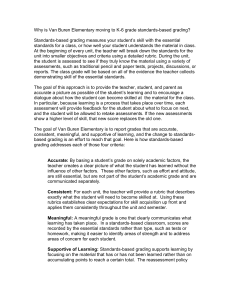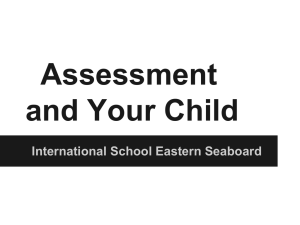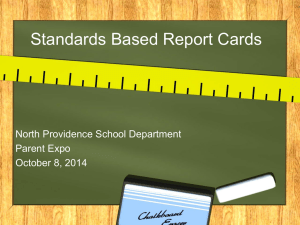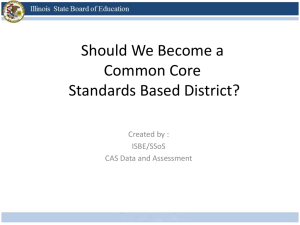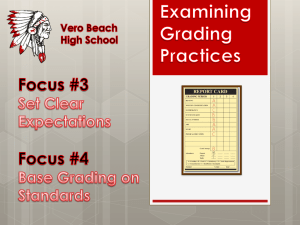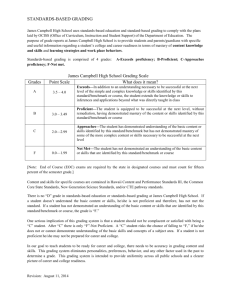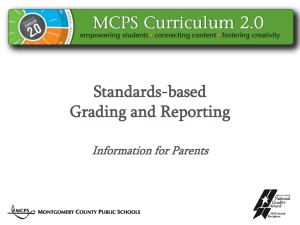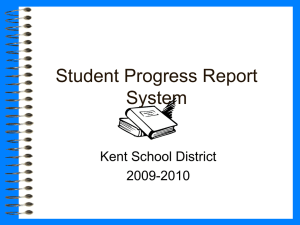Based Assessment Frequently Asked Questions
advertisement
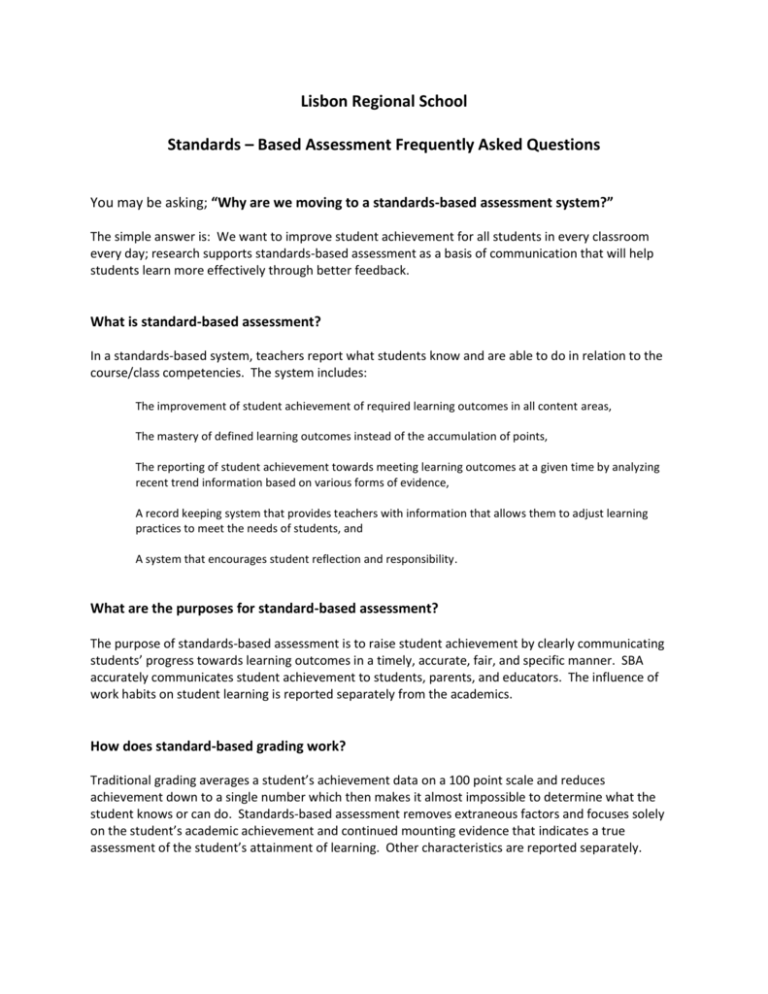
Lisbon Regional School Standards – Based Assessment Frequently Asked Questions You may be asking; “Why are we moving to a standards-based assessment system?” The simple answer is: We want to improve student achievement for all students in every classroom every day; research supports standards-based assessment as a basis of communication that will help students learn more effectively through better feedback. What is standard-based assessment? In a standards-based system, teachers report what students know and are able to do in relation to the course/class competencies. The system includes: The improvement of student achievement of required learning outcomes in all content areas, The mastery of defined learning outcomes instead of the accumulation of points, The reporting of student achievement towards meeting learning outcomes at a given time by analyzing recent trend information based on various forms of evidence, A record keeping system that provides teachers with information that allows them to adjust learning practices to meet the needs of students, and A system that encourages student reflection and responsibility. What are the purposes for standard-based assessment? The purpose of standards-based assessment is to raise student achievement by clearly communicating students’ progress towards learning outcomes in a timely, accurate, fair, and specific manner. SBA accurately communicates student achievement to students, parents, and educators. The influence of work habits on student learning is reported separately from the academics. How does standard-based grading work? Traditional grading averages a student’s achievement data on a 100 point scale and reduces achievement down to a single number which then makes it almost impossible to determine what the student knows or can do. Standards-based assessment removes extraneous factors and focuses solely on the student’s academic achievement and continued mounting evidence that indicates a true assessment of the student’s attainment of learning. Other characteristics are reported separately. How is standards-based assessment different? The student’s level of proficiency is more accurately represented. The progress toward proficiency of competencies is stressed more than in the traditional grading system. Subject areas and grade level competencies are clearly defined and related to learning outcomes that students need to learn and master. Each competency is assessed multiple times. All assessment formative as well as summative, are analyzed to provide a clear picture of the student’s overall proficiency as they relate to the course/class competencies, which differs from the traditional system for having one letter or number to represent competence. What are the advantages of standards-based assessment? Learning outcomes are clearly articulated to the students throughout instruction. Meaningful feedback is provided to the students during the entire learning process. Parents and students can see which learning outcomes students have mastered and which ones need re-teaching or re-learning. Some students struggle at the beginning of units, and in the traditional system, when averaging grades, they will feel as if they are lost and just give up. In SBA system the door remains open for them to master standards, regardless of time or past performance. The mastery of the standard is most important not the failure of assessments early on in the learning process. What are the disadvantages of standard-based assessment? Of all aspects of our education system, none seems more impervious to change than grading and reporting. Changing long-held traditions is a difficult and lengthy process. Why aren’t grades just averaged? Because the purpose of a standards-based assessment system is to report what students know and are able to do, averaging does not represent an accurate picture of where a student is in his/her learning. A student who struggles in a class at the beginning of a grading period and receives poor grades, but who keeps working and by the end of the grading period can clearly demonstrate competence in the subject, should receive a grade that reflects that competence. The average is a fixture in most grading systems, but the average does not always represent the data accurately. Consider two students, Stewart and George. Stewart earns the following scores: 85, 85, 85, 85, 85, 85, 85, 85, 85, and 85. The average is not difficult to calculate, Stewart’s grade is posted as a B. George struggles in math and turns in this performance: 50, 60, 65, 70, 80, 85, 90, 90, and 90. His mean score is a little over 75 which would result in a D on his report card, but it is obvious that George now understands the math even though he struggled in the beginning. To be truly standards-based, the most important thing is to accurately report proficiency levels of students on the required competencies in the course/class, and averaging just does not do this. How are we going to teach our students that in the real world or on test such as the NECAP, SAT, etc., they must do their best the first time? Our goal is student learning. We all know students learn at different rates, and students have issues that may affect their testing ability on a given day. Many real-life final tests such as driver’s license, SAT, ACT, bar exam, MCATS, Olympic trials, etc. offer multiple opportunities for mastery with no penalty for number of attempts. There are still deadlines within units and some of the practice work is time-bound. There are indeed cut off times for assignments per teacher discretion when late work will simply not be accepted because the unit is over. How will student progress be measured? All courses and grade levels have developed competencies that need to be mastered by the end of the course/grade. Teachers collect evidence of student understanding through observations, class work, projects, and formative and summative assessments, and then evaluate overall performance using the following scale: 4 – 3 – I – N (4 –Proficient with Distinction, 3 – Proficient, I – Incomplete, N – No Attempt/Progress). How will the move to standards-based assessment affect high school? The high school will still report GPA and class rank on the student’s transcript. Yes, we will still have a Valedictorian and Salutatorian, and yes, we will recognize students for exemplary work as it relates to proficiency levels of performance periodically throughout the school year. Colleges continue to use GPA and class rank while acknowledging their limitations. Along with GPAs, colleges rely on ACT, SAT, as well as the rigor of classes taken and their admission essays to evaluate students for admission. The last thing we want to do is jeopardize the chances of any of our students to be accepted to the college of their choice or be excluded from any scholarship monies available to them.
